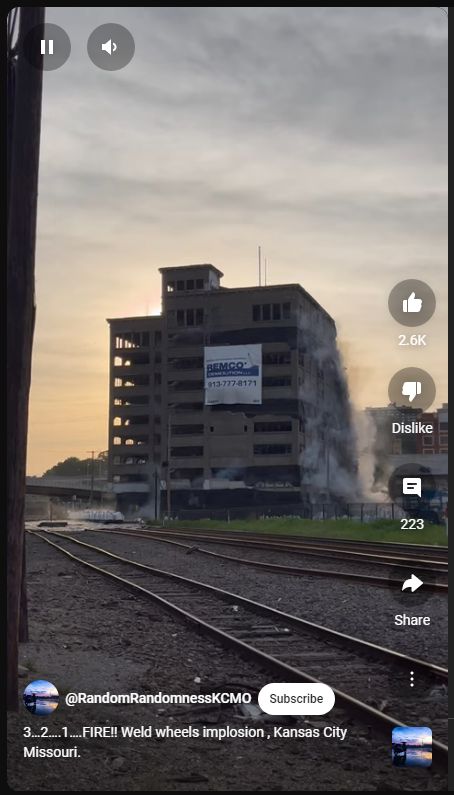“Looks like a plane hit it” LOL
Compare your memory to real controlled demo
Controlled Demolition vs. the 9/11 Dust Cloud: Understanding the Physics
The collapse of a building through controlled demolition and the lingering dust cloud after the 9/11 attacks present a fascinating and stark contrast. In controlled demolitions, the dust typically does not rise above the height of the original structure, whereas the dust from the 9/11 World Trade Center collapse rose into the upper atmosphere and lingered for months. This discrepancy raises intriguing questions about the physics of dust behavior, the nature of the materials involved, and even controversial theories regarding the cause of the collapse.
Controlled Demolition: A Predictable Collapse
Mechanism and Methodology: Controlled demolition is a precise engineering technique used to bring down structures safely and efficiently. Explosives are strategically placed within the building, usually around key structural supports. When detonated, these explosives cause the building to collapse inward on itself, minimizing damage to surrounding areas.
Dust Behavior: In controlled demolitions, the dust generated typically does not rise above the height of the original structure. This phenomenon can be explained by several factors:
- Energy Release: The energy from the explosives is directed inwards, causing the building to collapse rather than explode outward. This inward collapse ensures that the dust and debris are confined to a relatively small area.
- Dust Weight and Density: The dust produced consists of heavy particles, primarily concrete, steel, and other construction materials. These particles are dense and tend to settle quickly due to gravity, limiting their rise.
- Pyroclastic Flow: A controlled demolition can produce a pyroclastic-like flow of dust and debris, which is a ground-hugging flow of hot gas and volcanic matter. While not identical to volcanic pyroclastism, the dust flow in demolitions behaves similarly, moving outward along the ground rather than rising into the air.
The 9/11 Dust Cloud: Anomalous and Prolonged
Unprecedented Collapse: The collapse of the World Trade Center towers on September 11, 2001, was an unprecedented event. The twin towers were hit by large commercial airplanes, leading to massive fires and structural failure. The manner in which the buildings collapsed and the subsequent behavior of the dust cloud were both unexpected and unusual.
Dust Behavior: The dust from the 9/11 collapse rose into the upper atmosphere and lingered for months, contrasting sharply with typical controlled demolitions. Several factors contributed to this behavior:
- Energy from Impact and Fires: The impact of the planes and the intense fires caused by burning jet fuel released a tremendous amount of energy. This energy not only contributed to the structural failure but also vaporized a significant portion of the building materials.
- Dustification: The term “dustification” refers to the fine particulate matter generated during the collapse. The buildings disintegrated into very fine dust, much lighter and more prone to atmospheric suspension than the heavier particles typical of controlled demolitions.
- Pyroclastism: Unlike a controlled demolition, the collapse of the towers released a cloud that behaved more like volcanic ash, rising high into the atmosphere. The heat from the fires and the energy of the collapse created convection currents, lifting the dust upwards.
Particle Beam Weapon Theory: Some controversial theories suggest that unconventional technologies, such as particle beam weapons, might have played a role in the towers’ collapse and the unusual behavior of the dust. Proponents of this theory argue that:
- Unusual Dust Behavior: The fine nature of the dust and its prolonged suspension in the atmosphere might indicate a form of energy other than conventional explosives or structural failure was involved.
- Energy Signature: A particle beam weapon could theoretically provide the necessary energy to disintegrate materials at a molecular level, resulting in the observed “dustification.”
- Lack of Expected Debris: The relatively small amount of large debris and the presence of fine dust might suggest an alternative cause beyond the impacts and fires.
Physics of Dust Rising
Weight and Density: The behavior of dust particles is influenced by their weight and density. Heavier and denser particles settle quickly, while lighter particles can remain suspended for extended periods.
Convection Currents: Heat from fires or explosions can create convection currents, lifting dust particles into the air. The intensity of the fires on 9/11 likely generated strong convection currents, contributing to the rise of dust into the upper atmosphere.
Atmospheric Conditions: Weather patterns and atmospheric conditions can affect how long dust remains suspended. Favorable conditions on 9/11 may have facilitated the prolonged presence of dust in the atmosphere.
Conclusion
The contrast between controlled demolitions and the 9/11 collapse provides insight into the behavior of dust and debris under different conditions. Controlled demolitions result in confined dust clouds due to directed energy release and the heavier nature of the particles. In contrast, the 9/11 collapse produced an unprecedented and prolonged dust cloud due to the immense energy released, the fine nature of the dust, and strong convection currents. While the particle beam weapon theory remains controversial and largely unsubstantiated, the unique characteristics of the 9/11 dust cloud continue to provoke investigation and discussion among researchers and theorists.
